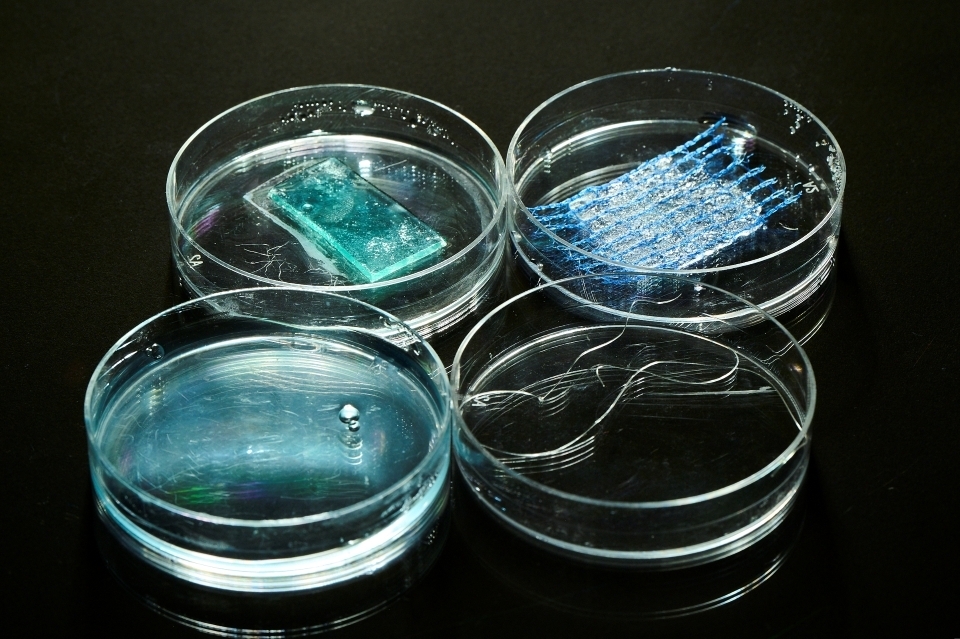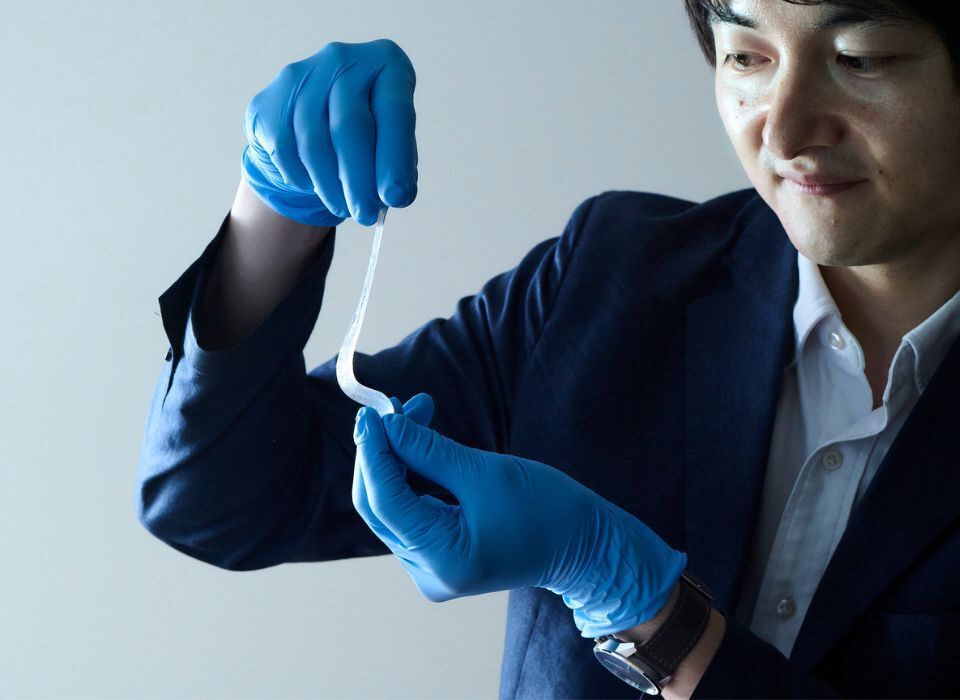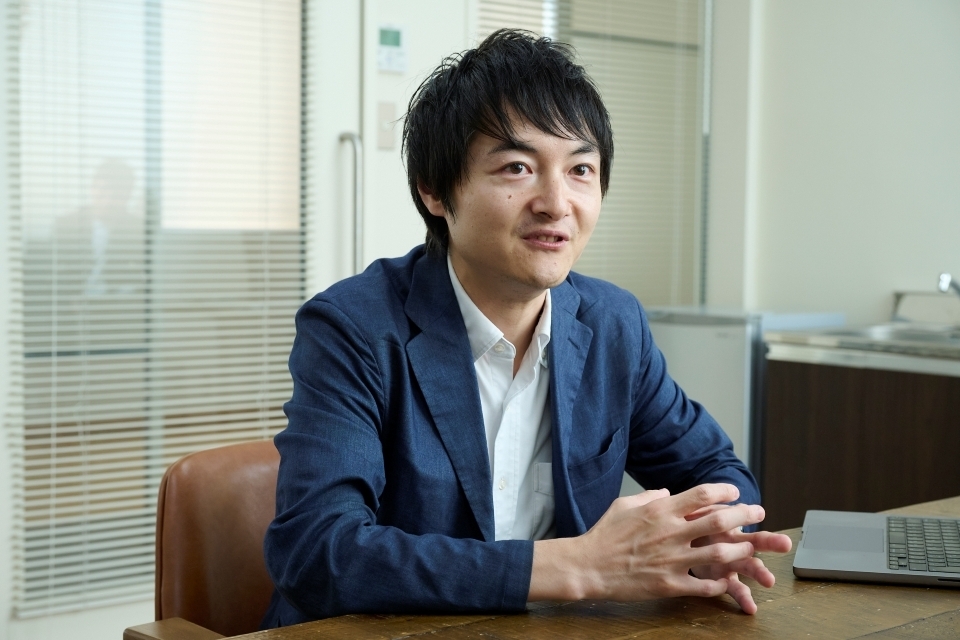Jelly, tofu, soft contact lenses—these familiar products are all substances in a state known as “gel.” In fact, the human body itself can be said to be mostly gel making it a highly biocompatible substance. Now, a biotech startup in Tokyo has developed a new kind of gel that promises to revolutionize medicine worldwide.

Multiple variations of tetra-gel. The upper left and right are sheet-shaped forms with potential as adhesion prevention materials for post-surgical organs. The slime-like form at lower left holds promise as an ophthalmic surgical aid for cataracts. At lower right is a high-strength fiber that can be used for artificial ligaments or sutures.
‘Gel’ is a state between liquid and solid. More specifically, gels are substances in which polymers—giant molecules composed of thousands of atoms bonded together—form a mesh that holds water. Because gel has properties similar to biological tissues, research has been advancing on its use as a biomaterial for surgery and regenerative medicine.
However, conventional gels have highly irregular polymer mesh structures that prevent the entire gel from having uniform properties. Until recently, it has been impossible to accurately predict how a gel’s properties might change after implantation in the human body. For example, 30 years ago, gel was implanted as an adjuvant for retinal detachment surgery, but its unexpected expansion caused a medical accident. Due to this instability, gel applications remained limited.
Now a Tokyo-based biotech startup has broken through this impasse in gel utilization and seeks to dramatically advance medicine with a unique new gel known as tetra-gel. MASUI Kosuke, CEO of Gellycle Co., Ltd., explains the advantages of tetra-gel: “This is a ‘next-generation’ gel with a stable, uniform mesh structure. It was invented in 2008 by my mentor, Professor SAKAI Takamasa of the Graduate School of Engineering at the University of Tokyo. Tetra-gel was created by chance during the research process, but the physical laws governing its behavior were subsequently verified, making it possible to predict how it would change. Therefore, we can now control the time the gel takes to change from liquid to solid, its strength, and even the size of its mesh.”

Tetra-gel can freely change shape, making it applicable to a broad range of treatments. Here, CEO MASUI Kosuke of Gellycle Co., Ltd. holds a strip of tetra-gel in slime form. If applied to a patient’s body with a medicinal component mixed in, the gel allows it to slowly dissolve in the affected area, providing long-lasting efficacy.
With gel properties finally controllable, the path has opened to widespread medical applications. In 2023, Gellycle announced the development of what could become the world’s first gel-based artificial tendons and ligaments. Masui explains that medical products like these will help address patient needs that have been overlooked until now.
“This is a term I coined, but I call them ‘unknown medical needs’: needs that have been left unmet by existing treatment methods but should be addressed. An example is Tommy John surgery, which many baseball players have undergone, most famously Shohei Ohtani. This surgery uses a tendon harvested from another part of the patient’s own body as a substitute for the damaged ligament. Currently, incisions must be made in two locations on the body, but if we use the artificial ligament we plan to develop, tendon harvesting would be unnecessary and the surgery could be completed in one procedure, improving patient QOL,” Masui says.
Research is also advancing on hemostatic agents that use gel to instantly stop bleeding that previously required several hours of direct pressure, and on diabetes treatment that eliminates the need for injections by placing gel infused with insulin on the skin.
That said, some people may feel resistant to having a “foreign object” like gel enter their bodies. However, Masui confidently declares, “Tetra-gel utilizes polyethylene glycol (PEG), which is already used in cosmetics and pharmaceuticals, including Covid vaccines, so its safety in the human body is guaranteed.”
Another promising area is regenerative medicine, which uses a patient’s own cells or genes. Treatment is said to cost hundreds of millions of yen due to the need to culture large quantities of harvested cells. By contrast, Masui says, “We aim to regenerate organs and bones simply by injecting gel into the body. Unlike biological approaches that inevitably require money and time for cultivation, an engineering approach using artificial tetra-gel that can be generated in the lab has the potential to significantly reduce both development and treatment costs.”
Gellycle adopts a platform-type development approach, providing tetra-gel—a globally unique material—to approximately 40 universities and companies both in Japan and abroad for joint research, rather than monopolizing it themselves. Leveraging partners’ ideas and resources allows for the unlimited expansion of tetra-gel’s applications. Another advantage is that commercialization can be achieved more quickly than if the company handled everything from development to product manufacture in-house. Currently, their target is to achieve large-scale implementation in both domestic and overseas markets by around 2030.
Regarding future prospects, Masui adds, “With the emergence of tetra-gel, gel research has reached a major turning point. Knowledge has been accumulated to the extent that we can now envision the creation of a new field of ‘gel science.’ From the simple jelly-like structure of ‘Gel 1.0,’ through ‘Gel 2.0,’ which provided higher strength and extensibility, we have now moved into the realm of ‘Gel 3.0,’ where we have succeeded in controlling gel’s physical properties. Using gel that belongs to this new generation, we want to fulfill the ‘unknown medical needs’ of patients not just in Japan but also overseas.”
Possessing properties compatible with the human body, gels can now be safely and efficiently applied to medicine. The day is not far off when the new possibilities developed in Japan for gels spread to countries around the world.

Masui Kosuke, CEO of Gellycle Co., Ltd.






























